A restrained start of the Bundesliga season for Schalke 04 and Bayern Munich as they both collected only a single point on the opening game. However, the second matchday brought the opportunity to improve it.
Wagner’s tactics relied on their pressing which, in fact, was an effective weapon in keeping Bayern Munich far from the goal. The control over the central zones made a difficult hindrance for Bayern to overcome. In results, the guests were not able to create that much threat thus Schalke were able to control the game without the ball, although Bayern were still able to grab the lead in the first half and won the game in the second half.
This tactical analysis will investigate the first Bayern Munich victory in the Bundesliga so far and more importantly, their possession play.
Lineups
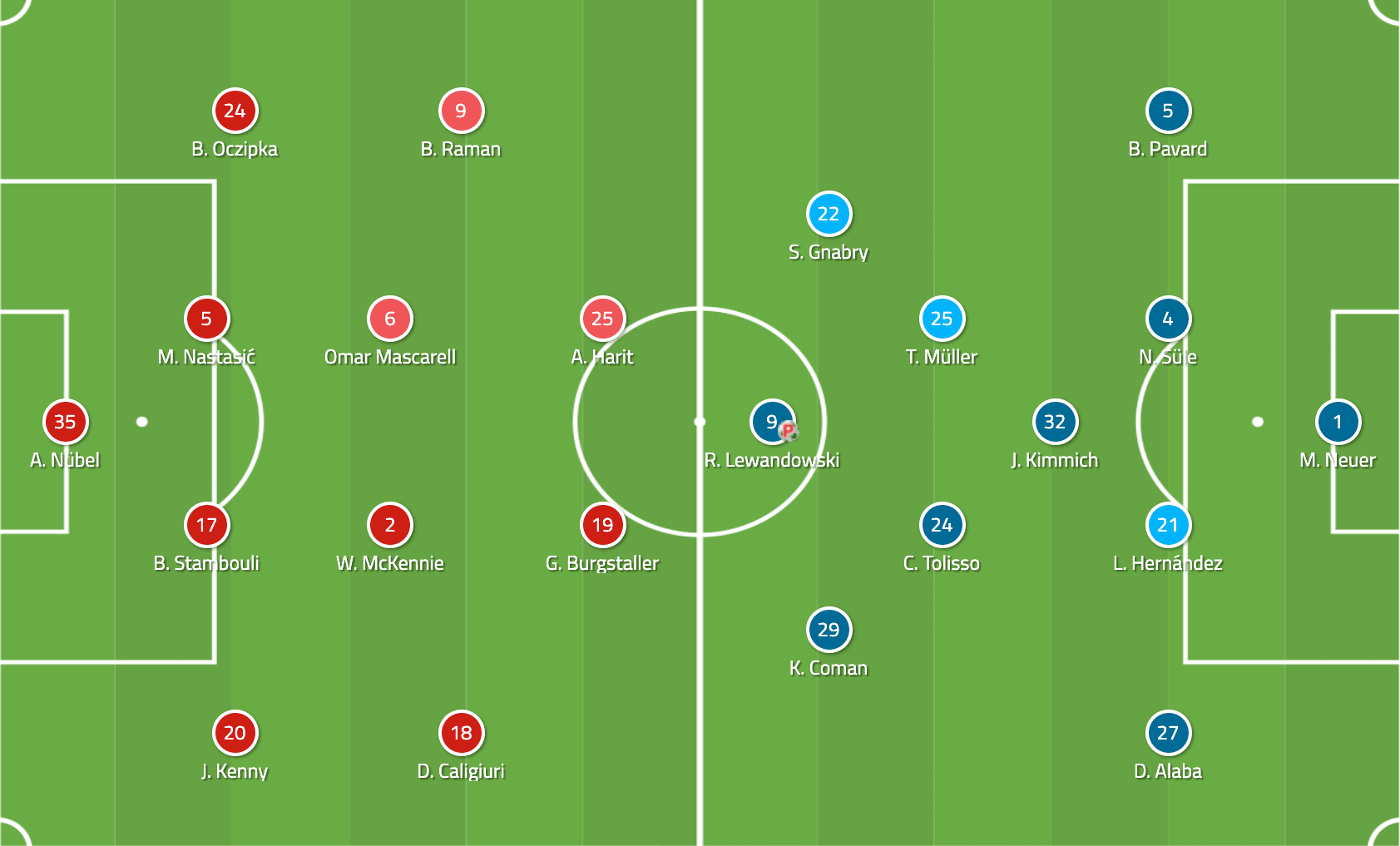
The new head coach, Wagner sent out the same starting XI, although in a different structure. Instead of the previously used 4-2-3-1, Wagner chose to line up in a 4-4-2 shape – at least on paper. No change in personnel.
Kovač deployed the same 4-3-3 formation but made some changes in order to gain more protection against counter-attacks, thus Joshua Kimmich replaced Thiago Alcântara in the #6 role to stabilise the midfield. Moreover, Benjamin Pavard moved out to the right full-back position and Lucas Hernandez paired up with Niklas Süle in the middle of the defence.
Schalke’s pressing vs Bayern’s build-up
The home side showed their tactics for this game early on. Schalke 04 pressed high up the pitch from the starting whistle, therefore the base 4-4-2 formation often morphed into something like a 4-4-2 diamond shape. Bayern Munich meanwhile had a 3-2-2-3 staggering in the build-up as Alaba usually occupied a bit higher than the rest of the last line, and stayed narrow (mostly in the left half-space). This way, Bayern’s formation became asymmetric and changed to a situationally three-at-the-back structure.
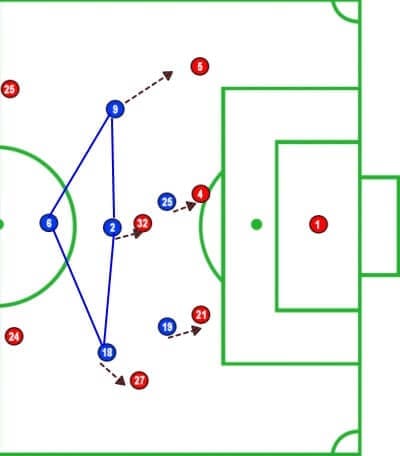
Wagner planned to block off the opponent from the centre. As the image above highlights, McKennie’s task was to mark Kimmich while Raman and Caligiuri closed on the full-backs, Pavard and Alaba thus leaving Mascarell alone. He positioned in the centre a bit deeper than the rest of the Schalke’s midfielders while Harit and Burgstaller were responsible for pressing the centre-backs and protecting the central zone.
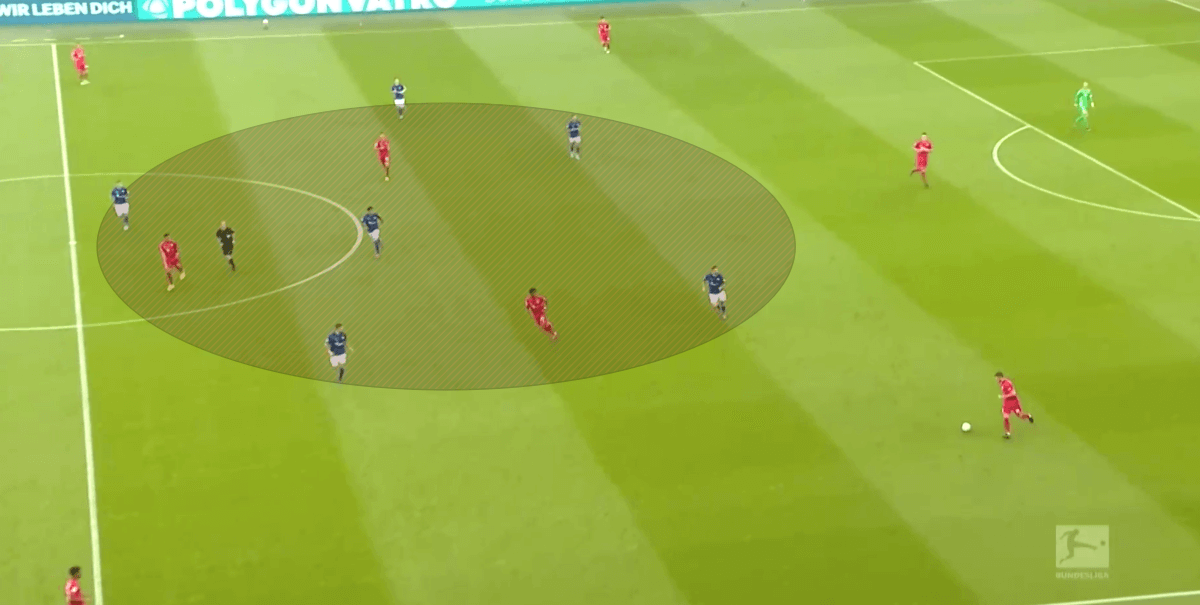
However, it did not work perfectly. Here, as the ball is played back to the centre from the left-wing and the two Schalke strikers tried to close in on Süle, he could find Kimmich with a pass. Truth to be told, it was a minor case.
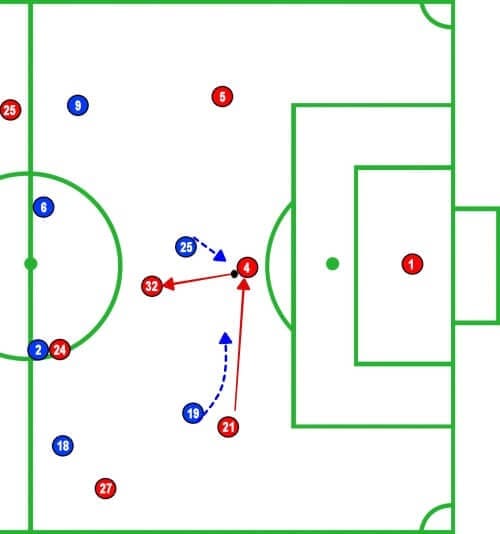
Once the ball was played wide, Schalke’s structure moved out to close down the lateral zones. With this shift, they were capable of closing down the way thus gaining control over the opponent’s progression.
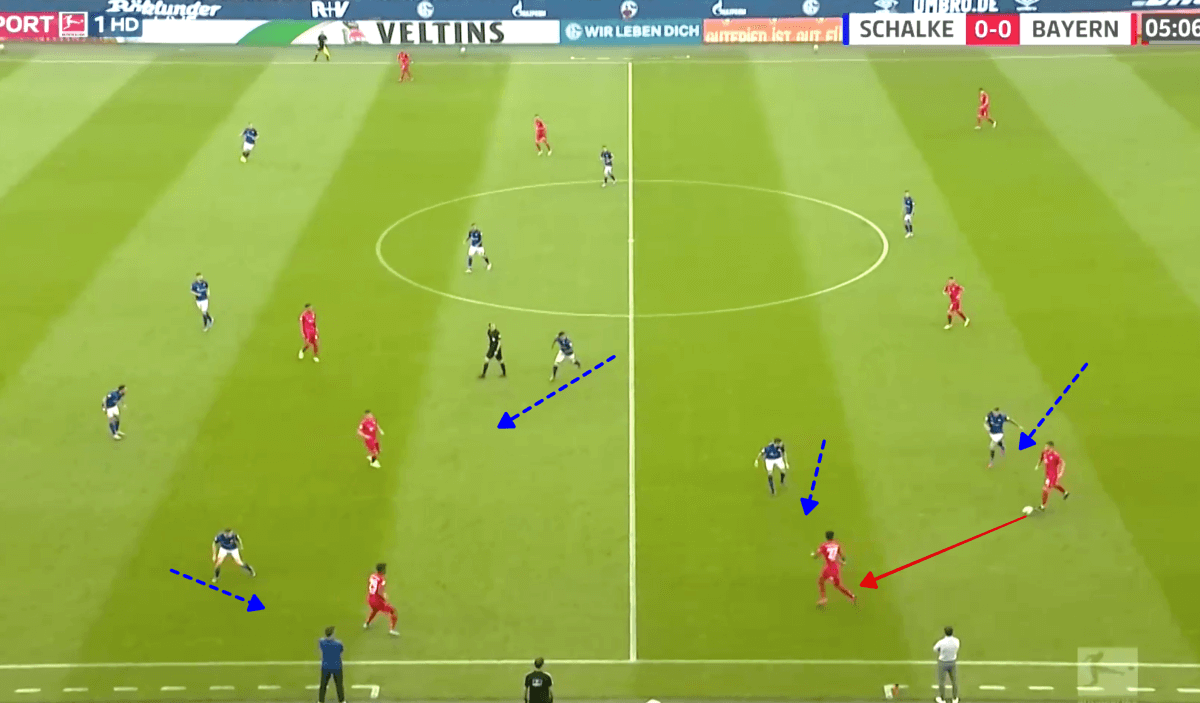
In this instance above, Burgstaller followed the advancing centre-back (Hernandez). The only passing option for him was Alaba since Kenny maintained close proximity to Coman, therefore when he passed to Alaba, it was not effective as Caligiuri was closing on Alaba. Hernandez probably should have made that pass earlier, but this isolation wasn’t the only instance- Schalke often blocked off the wing further up the pitch or deeper too.
In possession
Despite the foreign ground, Bayern Munich had the ball more which is a common scene as they usually have a higher possession rate. When they had the ball, Kimmich stayed deeper as a holding midfielder while both Tolisso and Müller moved forward in the half-spaces, although Tolisso often occupied the centre.
Furthermore, the wingers Kingsley Coman and Serge Gnabry stayed wide and high to stretch the oppositional last line to offer width and a content switching option. Usually they look for a one vs one situation against the opposition defender, but in this game, both were restricted as they were immediately closed down by Schalke’s full-backs. Even after a switch of play, therefore, they had to pass back.
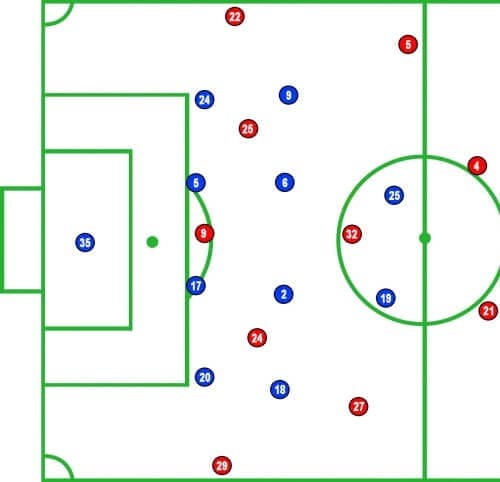
Due to the fact that Schalke 04 made a really good job in shifting to the ball-side and limiting the space even on the flanks, Bayern Munich struggled to break down this defensive organisation and get behind the opposition shape. Despite Bayern having a higher possession rate, they got one fewer shot than the home side. More importantly, only five out of ten shots occurred from open play.
Possible solutions
The fact that Schalke 04 occupied a narrow shape to protect the centre, it could be a good base point for finding the solution to the opponent’s tactics. Since they have to shift side to side in order to close down the wings, it is clear that it could take advantage of the shifting movement and space on the far side. However, instead of switching the play to the winger, Bayern showed a much better version of it.
In the first instance, Bayern played the ball from the right-wing to the left. When Alaba received the ball, Daniel Caligiuri moved out diagonally to press him, however, it was a bit late, especially compared to Raman’s movement. Previously, he moves out early to press Pavard right after he received the ball. However, in this situation below, Alaba had enough time on the ball to made a vertical pass but instead of a simple pass to Coman, he passed to Tolisso who runs from the centre to the left half-space. A pass to Coman would be pressed easily by the Schalke thus Tolisso’s movement was the key to play around the opponent’s block and find a breakthrough.
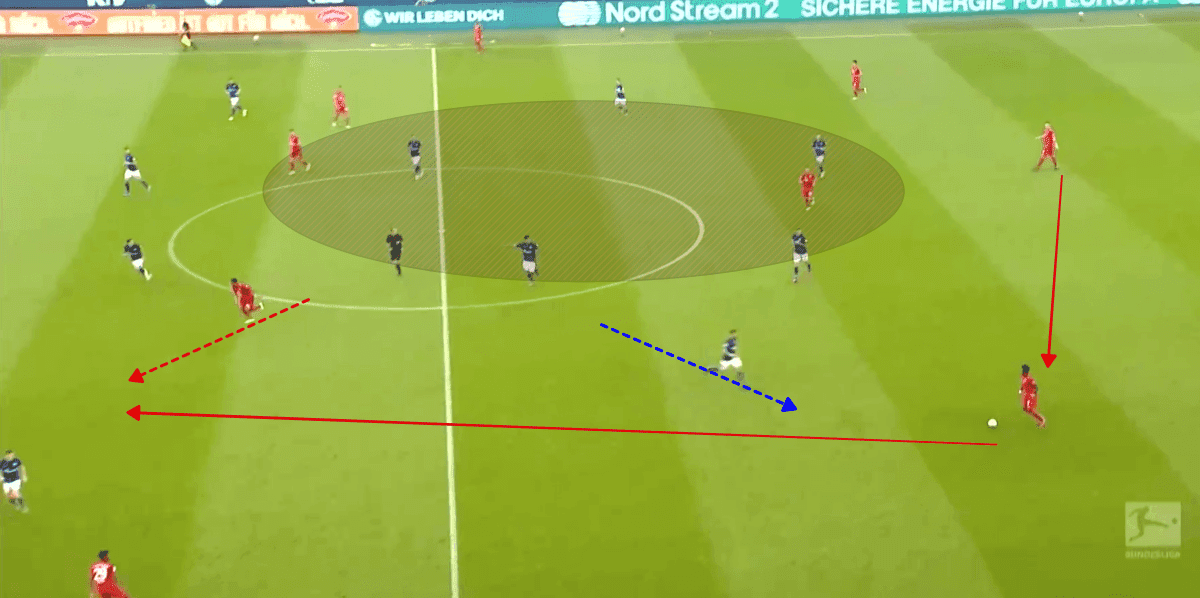
In the second example, in the 36th minute, Bayern used a switch of play again but this time Tolisso dropped to the deep left half-space to receive the ball. Alaba moved out wide whilst Coman moved infield from the wing. The key to this was Coman movement, which pinned back Schalke’s full-back who was kept away from Alaba who then was able to receive the ball in a free position from Tolisso.
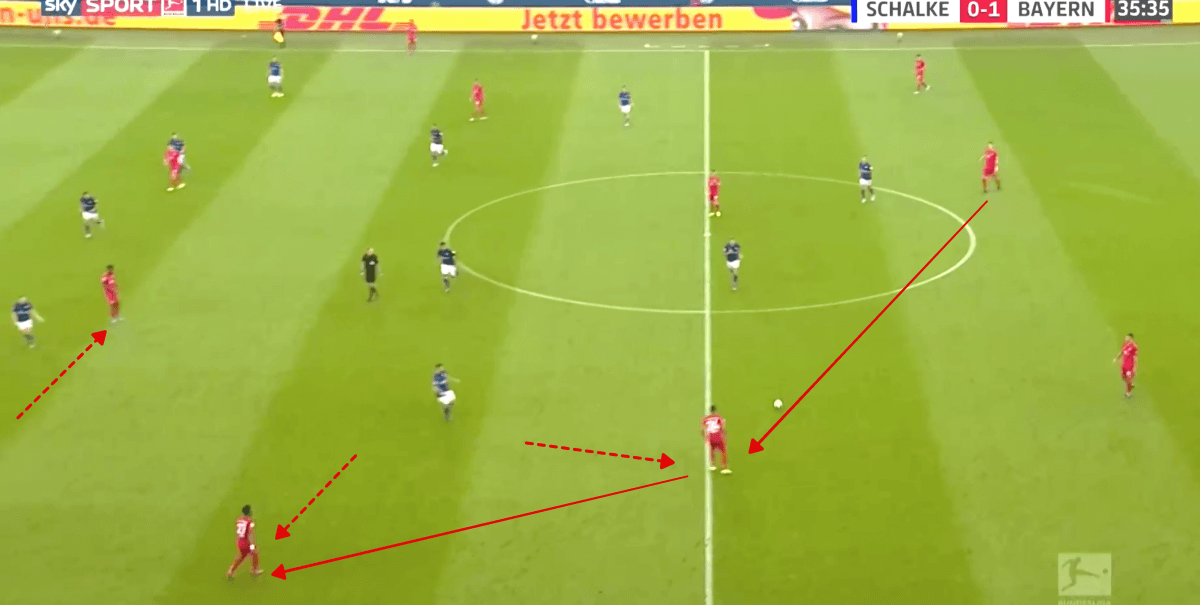
This scene showed two easy weapons for creating space and free a man against Schalke’s defensive organisation. Both a player rotation and pinning back is an effective tool to break down a defence.
With Coman’s narrow position and Alaba occupying out wide, Bayern could be more effective in the attacking phase. Perhaps with this structural change, they could pose more threats and have fewer issues in outplaying the opposition defence, especially if Tolisso were to keep staying in the half-space which pinned Schalke’s winger (Caligiuri) back from marking Alaba.
Final thoughts
As this analysis showed that although Bayern Munich had domination in term of possessing the ball 66% of the time, it was ineffective due to the good defensive work of Schalke 04. With this good pressing tactic, Bayern lacked quality scoring chances. Moreover only Gnabry’s impressive skills allowed them to score in the first half, as his dribble forced Schalke really deep meaning Bayern could pass to the penalty box where Coman could force out a bad tackle, which led to the penalty. The second goal had also come from a set-piece in the form of Lewandowski’s direct free kick.
So, in the end, the 3-0 victory for Bayern Munich was really flattering as they have issues in the attacking phase. They were effective in taking advantage of the opportunities but Niko Kovač’s side still have to work more on their build-up play as this match proved.
If you love tactical analysis, then you’ll love the digital magazines from totalfootballanalysis.com – a guaranteed 100+ pages of pure tactical analysis covering topics from the Premier League, Serie A, La Liga, Bundesliga and many, many more. Buy your copy of the August issue for just ₤4.99 here.

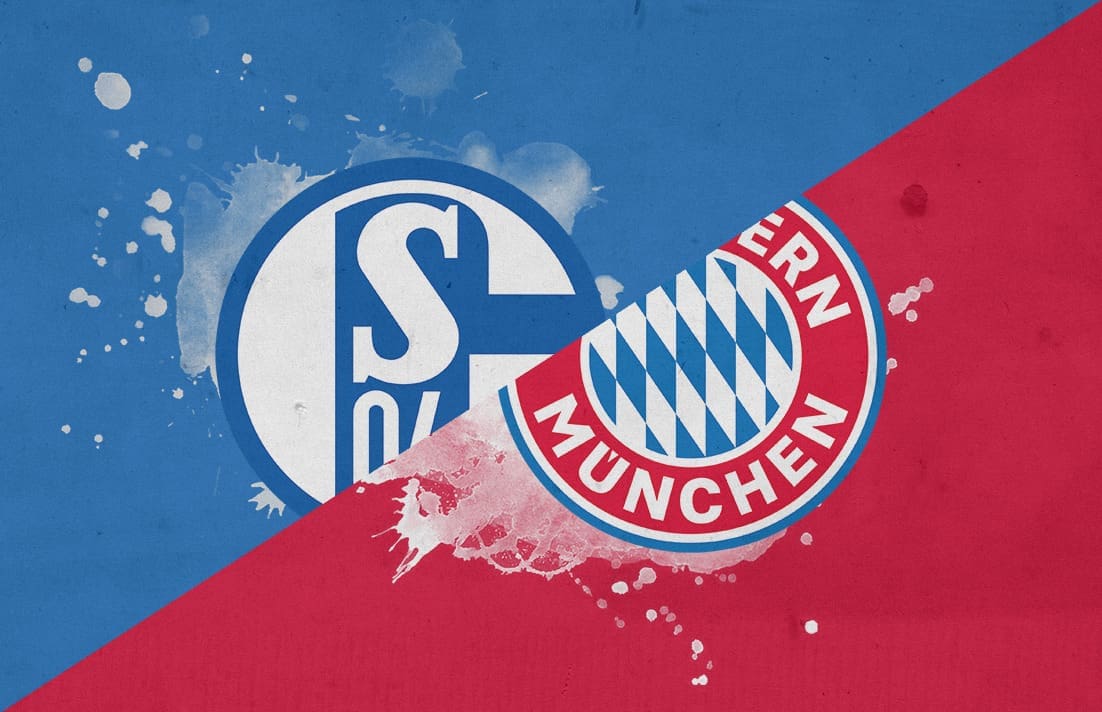



Comments